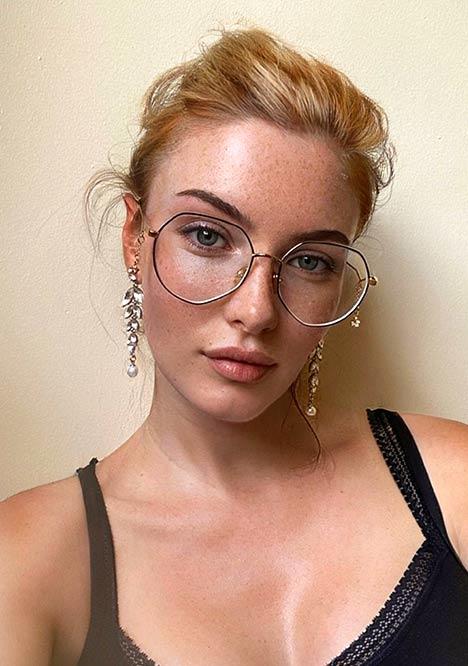Progressive lenses' pros and cons you should know
Progressive lenses, also known as multifocal lenses, progressive addition lenses (PAL), varifocal lenses, progressive power lenses, graduated prescription lenses or progressive spectacle lenses, are corrective lenses used to correct vision at different working ranges.

An updated version of bifocal and trifocal lenses, progressive lenses provide a seamless look, so sometimes they are called no-line bifocals. However, it might be more accurate to call them no-line trifocals.
Progressive lenses have three prescriptions in one pair of glasses allowing you to do close up work such as reading a book, middle-distance work such as using a computer and distance viewing, for example, driving without ever needing to change eyeglasses. The distance vision section of the lenses is usually in front of the pupil, whilst the near vision part is located in the lower section of the lenses.
They are used to correct presbyopia and other disorders of accommodation. Unlike bifocals, they have a gradual change in prescription strength and don't have visible separations between segments. As a result, progressive lenses look just the same as single vision lenses.
Most people's need for progressives lenses develops as they age. By the ages of 35-40, many have difficulty focusing their eyes on nearby objects. To compensate for this, some wear single-vision eyeglasses for distance as well as a separate pair for reading.

But progressive lenses eliminate this need for two pairs of glasses by using a gradual transition in prescription strength within one lens.
Advantages of progressive lenses
1. One pair of eyeglasses for everything
The first and foremost reason people opt for progressive lenses is that one pair has the functionality of three. With three prescriptions in one, there is no need to switch glasses constantly. It's one pair of glasses for everything.
2. No distracting bifocal line
The drastic difference between prescriptions in bifocal lenses is often distracting and even dangerous if you are using them whilst driving. However, progressive lenses offer a seamless transition between prescriptions allowing them to be used in a much more natural manner.
If you have already owned a pair of bifocals and found the sharp difference in prescription types distracting, then progressive lenses may hold your solution.
3. A modern and youthful Lens
You may be slightly self-conscious about wearing bifocal lenses due to their associations with old age, especially if you are younger. However, progressive lenses look just like single lens glasses and don't come if the same stereotypes that are associated with bifocals. Since they don't have a big difference between prescriptions, the bifocal line isn't visible to others. So they don't come with any of the troubling stereotypes associated with bifocal glasses.

Disadvantages of progressive lenses
1. It takes time to adjust.
Getting used to using progressive lenses takes some time and effort. You need to train your eyes to look through the downwards section of the glasses for reading, look straight ahead for distance and look in between for medium range work such as using a computer.
During this learning period, you may struggle with headaches, nausea and dizziness due to looking through the wrong sections of the lens. Some people never adjust to the change, but most people do, so luckily, this is only a temporary issue.
2. Visual distortions
The gradient in prescription types can cause visual distortions often just out of your periphery. This may be annoying or troublesome, especially since it can cause problems performing tasks such as stepping up curbs and climbing flights of stairs.
The bottom section of the glasses is used for close up work such as reading. As such, when you look down to take a step, your feet will appear larger, and it will become difficult to gauge your step. Visual distortions such as this will decrease as you get used to using the glasses but can be pretty troublesome, especially if you are already prone to falls or have coordination issues such as dyspraxia.
3. Higher cost
There is a significant price gap between the cost of progressive lenses and bifocals. If you are short on cash, then bifocals are the better choice of the two since they tend to be considerably cheaper. However, the benefits of progressive lenses often outweigh the cost. It is simply a question of what features you value most in your glasses.
Best glasses frames for progressive lenses
1. Lindsay

The orange color on this Lindsay glasses looks fully of energy. This is the glasses that can uplift your whole appearance, making you more vibrant. Also, this rounded cat-eye shaped frame looks gentle and cute. This glasses will leave a deep impression on others.
2. Jayce

Teal and pink colors are both soft and soothing. This aviator glasses won't make itself shining alone, but it will also make you look chic and stylish. The gentle aviator design lets the style look cool and catchy.
3. Giselle

Cute square lenses and vintage tortoise shell pattern make this Giselle glasses. Its metal temple arms look even more elegant and classic. From formal to casual occasions, this square glasses is always a good accessory for you.
Find more about this topic:
What are advantages and disadvantages of progressive lenses
What are the advantages and disadvantages of bifocal lenses
What is the difference between single vision and progressive lenses
How do varifocal lenses work? Pros, cons, and more
Transition lenses problems you should know
Bifocal glasses explained: how do they work?
Are progressive glasses a good idea?
Bifocal vs. progressive lenses: which are better for you?



















